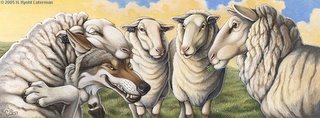
Fables are very short tales that illustrate clear and often directly stated moral (a principal of right or wrong behavior). The characters are often animals that act like humans, although this is not always the case. Sometimes the characters might be a cloud, or even a chair. These characters, however, have human characteristics. This is called personification and is often employed to give characteres faults and qualities similar to that of a person.
Aesop's Fable
"The Wolf in Sheep's Clothing"
A certain wolf could not get enough to eat because of the watchfulness of the shepherds. But one night he found a sheep skin that had been cast aside and forgotten. The next day, dressed in the skin, the wolf strolled into the pasture with the sheep. Soon a little lamb was following him about and was quickly led away to slaughter.
That evening the wolf entered the fold with the flock. But it happened that the shepherd took a fancy for mutton broth that very evening and, picking up a knife, went to the fold. There the first he laid hands on and killed was the wolf.
*Moral: The evil doer often comes to harm through his own deceit.
That evening the wolf entered the fold with the flock. But it happened that the shepherd took a fancy for mutton broth that very evening and, picking up a knife, went to the fold. There the first he laid hands on and killed was the wolf.
*Moral: The evil doer often comes to harm through his own deceit.
Links:
